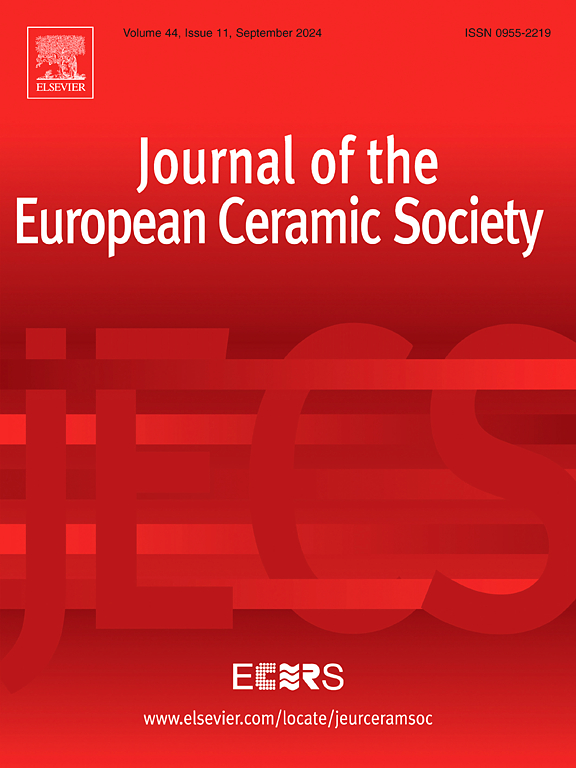Microstructure and coloration mechanism of Yue celadon of Three Kingdoms and Western Jin Dynasties (220–316 CE)
IF 5.8
2区 材料科学
Q1 MATERIALS SCIENCE, CERAMICS
Journal of The European Ceramic Society
Pub Date : 2025-05-02
DOI:10.1016/j.jeurceramsoc.2025.117477
引用次数: 0
Abstract
Yue celadon in the Three Kingdoms and Western Jin Dynasties, unearthed from Fenghuangshan kiln site in China, is a representative of early mature porcelain, reflecting the highest level of porcelain production at that time. It plays an important role in studying the evolution of the manufacturing technology of Yue celadon. Here, for such early Yue celadon, the microstructure and coloration mechanism, as well as composition characteristics, were comprehensively investigated by external-beam proton-induced X-ray emission (PIXE), optical microscope (OM), scanning electron microscopy coupled with X-ray energy dispersive spectroscopy (SEM-EDS), X-ray diffraction (XRD), Mössbauer spectroscopy, X-ray absorption fine structure (XAFS), and UV–Vis-NIR spectrophotometry. The results show that the celadon glaze of Fenghuangshan is very thin ( ), containing round bubbles. And the glaze belongs to the calcium glaze, with quartz and a small amount of anorthite crystals. The phases of the body include quartz and mullite. Iron, as a colorant in glaze, exists in the +2 and +3 valence states, and forms the octahedral coordination structures ( and ) bonding with oxygen, which was firstly discovered. The coloration of glaze is affected by the d-d transitions of and . With increasing Fe2+/Fe3+ ratios, the glaze color changes from yellowish-green to bluish-green. The bluish-green color was fired under a reducing atmosphere, whereas the yellowish-green color was fired under an oxidizing atmosphere. It provides a new insight for studying the microstructure and coloration mechanism of Yue celadon.
三国西晋越青瓷(220-316)的显微结构与显色机理
中国凤凰山窑遗址出土的三国西晋越青瓷是早熟瓷的代表,反映了当时瓷器生产的最高水平。这对研究越青瓷制作工艺的演变具有重要意义。本文采用外束质子诱导x射线发射(PIXE)、光学显微镜(OM)、扫描电镜耦合x射线能谱(SEM-EDS)、x射线衍射(XRD)、Mössbauer光谱、x射线吸收精细结构(XAFS)、紫外-可见-近红外分光光度法对早期越青瓷的微观结构、显色机理及成分特征进行了全面研究。结果表明,凤凰山青瓷釉非常薄(~ 100μm),含有圆形气泡。而釉属钙釉,含石英和少量钙长石晶体。身体的相包括石英和莫来石。铁作为着色剂,在釉中以+2价态和+3价态存在,并与氧形成八面体配位结构(Feoct2+和Feoct3+),这是首次发现的。Feoct2+和Feoct3+的d-d转变影响釉的着色。随着Fe2+/Fe3+比例的增加,釉色由黄绿色变为蓝绿色。蓝绿色是在还原性气氛下烧制的,而黄绿色是在氧化性气氛下烧制的。为研究越青瓷的微观结构和着色机理提供了新的视角。
本文章由计算机程序翻译,如有差异,请以英文原文为准。
求助全文
约1分钟内获得全文
求助全文
来源期刊

Journal of The European Ceramic Society
工程技术-材料科学:硅酸盐
CiteScore
10.70
自引率
12.30%
发文量
863
审稿时长
35 days
期刊介绍:
The Journal of the European Ceramic Society publishes the results of original research and reviews relating to ceramic materials. Papers of either an experimental or theoretical character will be welcomed on a fully international basis. The emphasis is on novel generic science concerning the relationships between processing, microstructure and properties of polycrystalline ceramics consolidated at high temperature. Papers may relate to any of the conventional categories of ceramic: structural, functional, traditional or composite. The central objective is to sustain a high standard of research quality by means of appropriate reviewing procedures.
 求助内容:
求助内容: 应助结果提醒方式:
应助结果提醒方式:


